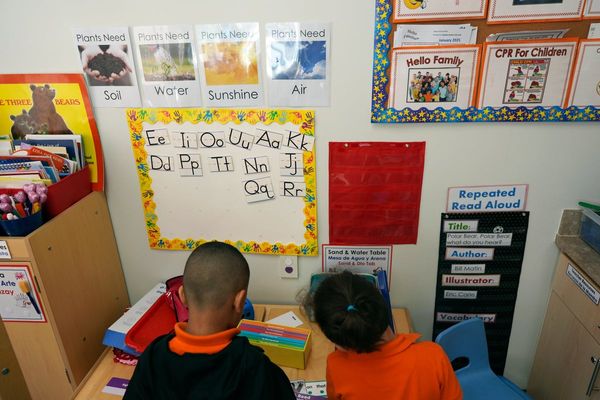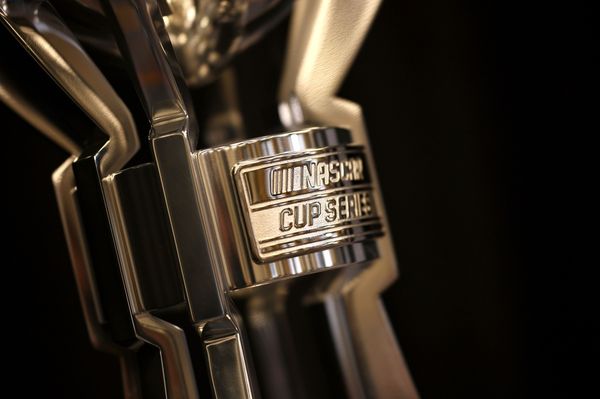
There is a beautiful work in The Weight of Words, a show about the overlap between poetry and sculpture, that consists entirely of a single noun printed in grey on a page. “Stilllife” is the word – every letter, except for the first and the last, running together in a fence of shadowy verticals.
It alludes to the art of still life painting, of course, where drooping flowers are supposed to double as memento mori. But more than that, it speaks of life stilled to the point of death. The ashen colour is nearly fading away, and turns out to be the grey of something less vital than paint. Czech artist Pavel Büchler made this work in 2017 using only dust. A tiny filament stands just proud of the surface, turning the work into sculpture.
Words appear in art from first to last. They are so common on public monuments in particular, from classical statues to Maya Lin’s Vietnam veterans’ memorial, its roll call of the dead multiplying into the black-granite distance, as to seem almost unexceptional. But very few sculptures are specifically concerned with – or composed of – words. This exhibition, at the ever-innovative Henry Moore Institute in Leeds, gathers works by 18 contemporary artists that ponder the written and spoken word to fascinating, curious and occasionally bewildering effect.
Here is a sculpture by South Korean artist Joo Yeon Park composed of mirrored metal to thwart (even further) your reading of the broken sentences incised in its reflective surfaces. Perhaps your words are written on water, so to speak? And here’s another by the Slavs and Tatars collective, co-founded in 2006 by a US-born Iranian and a Pole, that shows a tongue torn in two directions, doing the splits like some linguistic gymnast. A forked tongue, a tongue twister, foreign tongues and doublespeak: this shiny silver tongue embodies them all.

The American artist Glenn Ligon takes a line from Gertrude Stein – “Rose laughed when she was happy but she had not the wide, abandoned laughter that makes the warm broad glow of negro sunshine” – and turns it into a devastating sculpture. The last two words of the sentence are scripted in neon, the tubing then painted matt black. Yet the light cannot be stopped, continuing to radiate gloriously behind them. Ligon’s sculpture effectively eclipses the racism of Stein’s line, while preserving his own glow around it.
Words take shape, and letters have form. The Iranian artist Parviz Tanavoli sculpts a standing figure in radiant green fibreglass based entirely on calligraphy. It leans forward, hunched and ready to leap, two eyes in its quasi-abstract head. Somewhere between animal and man, it is an anthropomorphic creation. The form derives from the three letters that make up the Farsi word for nothing: heech. But as Tanavoli proposes, with his wry and vital figure, this is not nothing, but “a nothing that brimmed with life itself”.

This is a rare vein of art: subtle, pensive, philosophical. It is not without its famous exemplars. Consider Robert Indiana’s celebrated Love, on show at nearby Yorkshire Sculpture Park, in which the giant letter “O” swoons next to the letter “L”, as if knocked sideways with love. Or Mark Wallinger’s Self (Times New Roman), which resembles a classical column but is in fact an enormous capital letter “I” cast in blackened steel. The fundamental pronoun, the simplest of words, a person reduced to a letter that is supposed to represent a whole self, in this case scaled up to exactly Wallinger’s own height.
The sculptures in this show generally depart from traditional methods of casting, modelling or carving. The celebrated Colombian artist Doris Salcedo amalgamates what appear to be wooden pulpits and domestic furniture into mute blocks, stifled at every aperture with concrete. A dumb and poignant hulk, her work Untitled (2008) feels like words lost, mouths stopped, the heavyweight expression of a silencing.
Beside it, Emma Hart’s ceramic whorls, ranged along the walls like archery targets or sound-wave emojis – concentric circles in vivid colours – feel cheerful but light as their title, Good Vibrations. And Shanzhai Lyric’s Incomplete Poem (Hedge), an installation in which T-shirts bearing pastiches of those modish slogans that appear in mistranslation on Chinese garments are draped over a wooden frame, just keeps on repeating its central point about globalisation, capital and commodity.

But true poetry emerges just as you are beginning to wonder whether these artists were going to make more of, and with, words. Bhanu Kapil is herself a poet, of Indian descent. Her volume The Vertical Interrogation of Strangers, published in 2001, is partly reprised here in the form of 12 questions inscribed on a staircase. It begins innocently enough – “Who are you and whom do you love?” – but grows increasingly intense. “How will you live now?”, “Who was responsible for the sufferings of your mother?” and “What are the consequences of silence?” As the steps rise upwards, so the seriousness escalates. “How will you… prepare for your death?”

Most profound is the Indian artist Shilpa Gupta’s split-flap display board, suspended from the ceiling and constantly shifting like its real-life counterparts in stations and airports, upon which departure details are constantly updated. This one cannot quite spell, nor clearly enunciate, and yet it seems to want to speak. Its utterances are about words, their sounds and meanings, about those who control them, those who avoid them, about authority and fear, life and death. Its fluttering motion is increasingly audible and urgent – the sound, as it seems, of this kinetic sculpture’s own inner voice.
The Weight of Words is at the Henry Moore Institute, Leeds, until 26 November







